#087: Gymnosporangium juniperi-virginianae, Cedar-Apple Rust
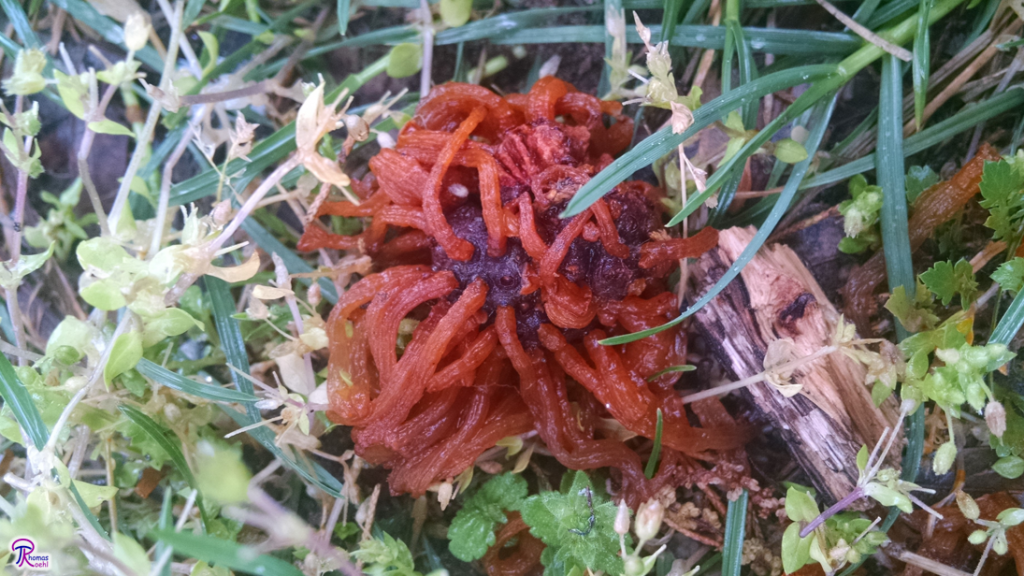
Gymnosporangium juniperi-virginianae produces one of the most bizarre fruiting bodies of all fungi: orange tentacles sprouting from a golf ball-like structure called a gall. The galls are usually found in trees, but this one fell to the ground during a thunderstorm.
Gymnosporangium juniperi-virginianae is a rust fungus known as Cedar-Apple Rust (sometimes abbreviated to CAR) that causes disease in Eastern Red Cedar and in apple trees. This fungus is unique among rusts because it produces large fruiting bodies. On cedar trees, the fruiting bodies resemble lumpy brown golf balls with long gelatinous orange tentacles bursting out of them. On apple trees, the disease causes more damage but produces only orangish spots. The complex life cycle of Cedar-Apple Rust means the fungus is easy to control, although these control methods resulted in a legal case that was argued before the Supreme Court of the United States!1,2
Description and Life Cycle
Gymnosporangium juniperi-virginianae is a member of the order Pucciniales.3,4 These plant diseases are commonly known as rusts (FFF#130), since they often make reddish or orangish spores.4 Many rusts have complex life cycles and produce multiple types of spores.1,4 Each spore type has its own name and function, which can get very confusing.1 A number of rusts are economically important, such as Coffee Rust (Hemilia vastatrix, FFF#049) and Black Stem Rust of wheat (Puccinia graminis, see FFF#208).1,4,5 Rusts are often heteroecious, which means they require two different hosts to complete their life cycle.1 Cedar-Apple Rust, as its name implies, is a heteroecious rust that infects Eastern Red Cedar trees and apple trees at different points in its life cycle.1,4,6–9
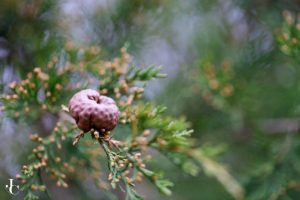
When the galls aren’t producing spores, they are brown lumpy growths and are difficult to spot. Photo by Jacqui Chiminello, used with permission.
G. juniperi-virginianae spends the winter in the branches of Eastern Red Cedar (Juniperus virginiana) and occasionally in other juniper trees.6,9,10 Cedar-Apple Rust infects branches of those trees and causes the formation of galls. Galls are abnormal growths formed by plants that prevent infection from spreading. In this case, they are brownish, roughly spherical, lumpy, pitted, and up to 3cm in diameter. These galls are not very noticeable for most of the year, but they really pop in spring. After rain in April and May, the fungus bursts out of the gall and produces large “telial spore horns.” In Cedar-Apple Rust, the spore horns are bright orange, conical, gelatinous, and up to 4cm long. The resulting fruiting bodies look something like a cross between an octopus and a tribble. Spore horns are designed to dry out and rehydrate eight to ten times over the season. Dried spore horns are tough and look like brownish spikes on the outside of the gall.1,4,6–9
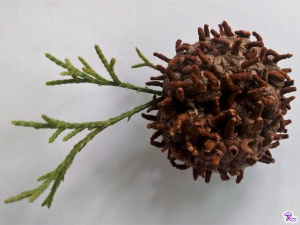
When dry, the telial horns are small and tough, but still slightly fleshy. They can dry out and rehydrate multiple times over the course of the season.
Fungal hyphae in the gall produce two-celled spores called “teliospores” on the spore horns. Each cell in the teliospore is dikaryotic. While still on the spore horn, the teliospore germinates to form a basidium. In the basidium, the two dikaryotic nuclei fuse to form a temporary diploid nucleus, which then goes through meiosis. The end result is the production of four haploid spores known as basidiospores. These spores are dispersed by the wind. Basidiospores of Cedar-Apple Rust infect only apple trees and cannot cause new infections in Eastern Red Cedar.1,4,7 The fungus in the gall dies once it releases its spores, so the infection must jump to an apple tree for the life cycle to continue.6
The basidiospores germinate only if they land on the leaf or the fruit of an apple or crabapple tree (Malus sp.) when conditions are right (8-24°C with adequate moisture). If the spore successfully germinates, it infects the leaf, causing a yellow or orange spot. After a week or two, the hyphae within this spot develop small, orange pustules – known as “spermogonia” or “pycnia” – on the upper surface of the leaf. These pustules produce spores called “spermatia,” “pycnidia,” or “pycniospores.” The surfaces of the spermatogonia are covered in a sticky liquid that attracts insects, which carry the spermatia from one spermatogonium to another. At this point, both the spermatia and the infective hyphae within the leaves contain only haploid nuclei. The spermatia function a lot like pollen in plants; when one spermatium is carried to a compatible spermatogonium, it germinates and fertilizes the spermatogonium. During fertilization the fungus within the leaf receives an extra nucleus from the spore and becomes dikaryotic.1,4,7
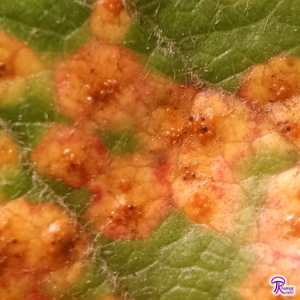
Leaves infected with Cedar-Apple Rust are dotted with small orange circles. In summer, the circles produce bumps on the top of the leaf called spermogonia.
A month or two later, the fungus produces structures on the bottom of the leaf known as aecia. Aecia are small lesions that start out orange and oozing but become brown and stringy. They form the fourth and final type of spore produced by Cedar-Apple Rust: the aeciospore. Aeciospores are dikaryotic (like their parent mycelium) and are dispersed by the wind. When aeciospores land on a branch of an Eastern Red Cedar tree, they germinate, infect the branch, and form a gall.1,4,7 Galls appear after about seven months of infection and are ready to form telial horns after 18 months. In all, the fungus’ life cycle takes two years to complete.6 Aeciospores infect only Eastern Red Cedar, so rust on apple trees cannot infect other apple trees.1 Since apple trees lose their leaves in fall, the fungus must infect Eastern Red Cedar to survive the winter and continue its life cycle.
Impact
G. juniperi-virginianae can be an economically important plant pathogen. If the infection is severe, apple trees may lose most of their leaves and the apples can become deformed, which results in loss of income for farmers.7 It can also damage Eastern Red Cedar trees, but this damage does not impact anyone economically.1
This situation resulted in a legal dispute that made it all the way to the Supreme Court of the United States. In 1912, apple orchards in the Shenandoah Valley were hit by a particularly hard rust epidemic. This led the state of Virginia to pass a law in 1914 that allowed the state to cut down any cedar tree within one mile (in 1920 that was raised to two miles) of an apple orchard if Cedar-Apple Rust was found in that orchard. The state requested landowners cut down the trees themselves, but paid to cut down the trees if the landowner refused to do so. Landowners were allowed to keep the lumber from the trees and Virginia often paid for the tree to be cut into firewood and fence posts. Money for cutting the trees was raised by a special tax on apple products.2
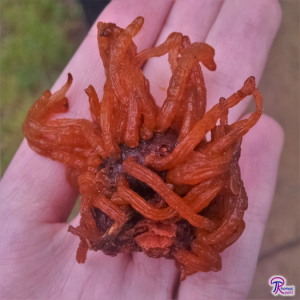
Cedar-Apple Rust is conspicuous on Eastern Red Cedar for a short period of time. This makes it much easier to simply cut down all the trees near an apple orchard rather than removing the individual galls.
This law suited orchardists but ruffled the feathers of cedar owners. One disgruntled landowner was Dr. C. O. Miller, who had over 200 cedars lining his driveway. The State Entomologist, W. J. Schoene (it fell to the State Entomologist to decide when to apply the 1914 law), determined that Miller’s trees had to be cut down. Miller was upset with this, since he estimated that removing the trees would devalue his property by between $5,000 and $7,000.2 Miller fought the 1914 law through both the state and federal court systems, arguing that the law was unconstitutional because it failed to allow for due process, did not provide equal protection, and did not give just compensation for his lost property value (Virginia paid Miller only $100 for the destruction of his trees). In every court, the justices decided that the law was constitutional. The case eventually reached the United States Supreme Court in 1928 as Miller v. Schoene. That court also sided with Virginia and Miller’s trees were cut down in 1929.2,11
Miller v. Schoene is still important in certain legal situations that I won’t pretend to fully understand. I am not a legal expert, so if you want to learn more about this case you’ll have to do your own research or contact someone who knows more about the law.
References to the case appear regularly in other “takings” cases, where the state takes or destroys private property. Specifically, Miller v. Schoene is important in nuisance cases (a disease of apple trees is a nuisance to orchardists) when considering due process and just compensation as required by the Fourteenth Amendment of the US Constitution. The 1928 Court decided that due process was served because cedar owners could contest that their trees were not within two miles of an orchard. Since due process was served, no just compensation was required. Interestingly, this decision seems to contradict an earlier decision by the Court in the 1922 case of Pennsylvania Coal v. Mahon. Both of these cases are still used by legal experts considering takings issues.2
Additionally, it often appears when discussing cases where state inaction causes harm. In Miller v. Schoene, Virginia could have just ignored the problem and let the orchardists deal with the rust on their own. By this inaction, however, Virginia would have made the choice to protect the property of cedar owners at the expense of orchardists’ property. Therefore, inaction is “none the less a choice,” as Justice Stone wrote in the majority opinion. That phrase pops up in discussions of a wide variety of cases concerning state action, the difference between private action and public action (and whether or not there is a difference), and laissez-faire economics.2
Solutions
Cedar-Apple Rust is fairly easy to manage with fungicides that prevent basidiospores from infecting apple leaves. Fungicides should be applied to apple leaves while G. juniperi-virginianae is actively producing teliospores. This period lasts for several weeks during the spring.4,6,7 Today’s fungicides are cheaper and less damaging to the trees than the fungicides in the 1910’s and 20’s, which explains why laws on Cedar-Apple Rust were necessary in the early 20th century.2
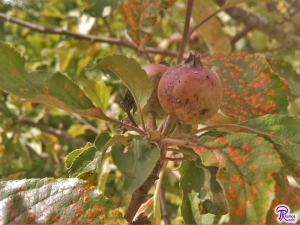
This apple tree is heavily infected with Cedar-Apple Rust. Sure enough, there was an Eastern Red Cedar just a few yards away. To stop the infection, the tree owners would simply have to cut down the Eastern Red Cedar.
However, Cedar-Apple Rust is also easily controlled without using chemicals, which is good news for small-scale growers or organic farmers. You can break the disease cycle by pruning galls from nearby Eastern Red Cedar trees or by cutting down those trees.1,4,6,9 There are also varieties of apple that are resistant to Cedar-Apple Rust.6,7,9 With these strategies, any infections that do occur will be limited infections that do not damage apple trees or their fruit. Orchardists can easily live with low levels of infection, since spores produced on apple trees cannot infect other apple trees.2
Taxonomy and Similar Species
G. juniperi-virginianae belongs to the order of rust fungi, Pucciniales. Most rusts have multiple spore types and infect two hosts, so Cedar-Apple Rust’s complex life cycle is normal compared to its relatives.1,4 There are a few closely related species that can infect both Eastern Red Cedar and apples, but these have smaller spore horns and broader host ranges. G. globosum is known as Cedar-Hawthorn Rust and infects apples, pears, quince, and serviceberry. G. clavipes is known as Cedar-Quince Rust and infects those hosts listed above as well as: other species in the rose family, flowering quince, mountain-ash, chokeberry, photinia, and cotoneaster.6,10
| Common Name | Cedar-Apple Rust | Eastern Red Cedar | Apple |
| Kingdom | Fungi | Plantae | Plantae |
| Subkingdom | – | Viridiplantae | Viridiplantae |
| Infrakingdom | – | Streptophyta | Streptophyta |
| Superdivision | – | Embryophyta | Embryophyta |
| Division (Phylum) | Basidiomycota | Tracheophyta | Tracheophyta |
| Subdivision (Subphylum) | Pucciniomycotina | Spermatophytina | Spermatophytina |
| Class | Pucciniomycetes | Pinopsida | Magnoliopsida |
| Subclass | – | Pinidae | Rosanae |
| Order | Pucciniales | Pinales | Rosales |
| Family | Pucciniaceae | Cupressaceae | Rosaceae |
| Genus | Gymnosporangium | Juniperus | Malus Mill.12 |
| Species | Gymnosporangium juniperi-virginianae Schwein.3 | Juniperus virginiana L.13 | (various) |
See Further:
http://botit.botany.wisc.edu/toms_fungi/may99.html
http://www.fs.fed.us/wildflowers/plant-of-the-week/gymnosporangium_juniperi-virginianae.shtml
http://www.mushroomexpert.com/gymnosporangium_juniperi-virginianae.html
Citations
- Volk, T. J. Tom Volk’s Fungus of the Month for May 1999. Tom Volk’s Fungi (1999). Available at: http://botit.botany.wisc.edu/toms_fungi/may99.html. (Accessed: 6th April 2018)
- Fischel, W. A. The Law and Economics of Cedar-Apple Rust: State Action and Just Compensation in Miller v. Schoene. (2004).
- Gymnosporangium juniperi-virginianae Schwein., Schr. naturf. Ges. Leipzig 1: 74 [48 of repr.] (1822). Index Fungorum Available at: http://www.indexfungorum.org/names/NamesRecord.asp?RecordID=140481. (Accessed: 6th April 2018)
- Taylor, D. Cedar Apple Rust. U.S. Forest Service Available at: https://www.fs.fed.us/wildflowers/plant-of-the-week/gymnosporangium_juniperi-virginianae.shtml. (Accessed: 6th April 2018)
- Rust (fungus). Wikipedia (2018).
- Cedar-apple rust. Missouri Botanical Garden Available at: http://www.missouribotanicalgarden.org/gardens-gardening/your-garden/help-for-the-home-gardener/advice-tips-resources/pests-and-problems/diseases/rusts/cedar-apple-rust.aspx. (Accessed: 6th April 2018)
- Pearson, R. C., Aldwinckle, H. S. & Seem, R. C. cedar apple rust. (1981).
- Kuo, M. Gymnosporangium juniperi-virginianae. MushroomExpert.Com (2006). Available at: http://www.mushroomexpert.com/gymnosporangium_juniperi-virginianae.html. (Accessed: 6th April 2018)
- Cedar-apple rust. University of Minnesota Extension Available at: https://www.extension.umn.edu/garden/yard-garden/fruit/apple-pest-management/cedar-apple-rust/. (Accessed: 6th April 2018)
- Cedar Rust Differences. University of Illinois Extension Available at: http://extension.illinois.edu/focus/index.cfm?problem=cedar-rust-differences. (Accessed: 6th April 2018)
- Miller v. Schoene. Oyez Available at: https://www.oyez.org/cases/1900-1940/276us272. (Accessed: 6th April 2018)
- Malus Mill. Integrated Taxonomic Information System Available at: https://www.itis.gov/servlet/SingleRpt/SingleRpt?search_topic=TSN&search_value=25254#null. (Accessed: 6th April 2018)
- Juniperus virginiana L. Integrated Taxonomic Information System Available at: https://www.itis.gov/servlet/SingleRpt/SingleRpt?search_topic=TSN&search_value=18048#null. (Accessed: 6th April 2018)


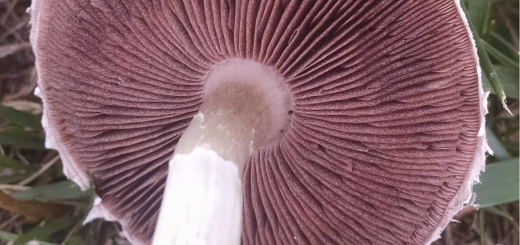
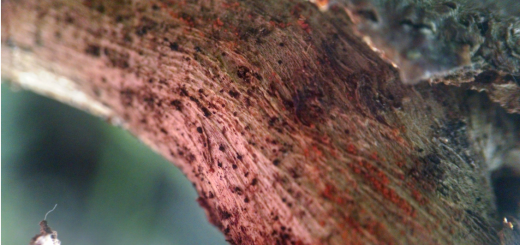





![#011: Characteristics of Kingdom Fungi [Archived]](https://www.fungusfactfriday.com/wp-content/themes/hueman/assets/front/img/thumb-small-empty.png)

Hi there! Question- is the gall the fruitbody of the fungus in this case, or is the gall produced by the tree, and in that case, is the gall considered more tree, or more fungus?
Good question – the gall is a little bit of both. Most of the tissue in the gall consists of plant cells. However, the fungus is growing through and feeding on the plant tissue. Without the fungus, the gall isn’t produced, so you need both fungal and plant cells to make a gall. The gall is mostly plant, but part fungus. However, the gall is not a fruitbody. For G. juniperi-virginianae, the fruitbody is the orange tentacles that grow out of the gall.
Thank you for your reply, Thomas! I have a gall on hand and am experimenting with it. So it would be correct to say that the gall is essentially the tree, but is parasitized or colonized by the fungus?
Yes. That’s a good way to think about it: essentially, it’s a symptom of a disease.
So, similar to the sclerotia associated with Inonotus obliquus, then. Thanks again! Do you have an instagram?
That’s right. Although, chaga is not a sclerotium (the structure and function are different). I do not have an Instagram (not yet, anyway).
Oh, interesting- the prevailing name for the growth in what I’ve read has been ‘sclerotia’. This is the term in the scientific papers I’ve seen as well as on Michael Kuo’s site. What would you call it? What is different about it from what you understand as sclerotium?
You’re right — ignore what I said. Sclerotium isn’t very well defined, so I probably use it in a more limited scope than most mycologists. The typical sclerotium is a knot of fungal tissue that stores food, usually to help the fungus overwinter. For a good example of typical sclerotia, see Hypholoma tuberosum. Morels make a structure with the same function, but it is actually a pseudosclerotium because it incorporates debris. Claviceps purpurea produces above-ground sclerotia that are a mix of fungal and plant tissue and are critical for overwintering. Chaga has a more irregular shape than typical sclerotia and isn’t enclosed by a hard rind on all sides (usually a requirement to be a sclerotium). Additionally, we don’t know its purpose: food storage might fit the definition, but if it’s primarily for gas exchange or toxin disposal it wouldn’t fit the definition. The structure is too messy and we we don’t know enough about its role, so I don’t like calling chaga a sclerotium. Instead, I use the non-scientific names “conk” or “clinker.” Personally, I think that since morels make pseudosclerotia, we should also have a specific term for sclerotia that include plant tissue and another term for chaga-like sclerotia. But my opinion doesn’t count for much, so use the terms you find in published research.